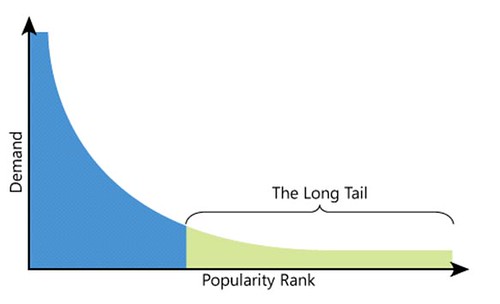
Martha Bush

The foundational concept of all database marketing is the Pareto Principle, that 80% of your sales and profitability will come from about 20% of your customers. When we have analyzed our clients’ customer bases to prove out this theory, we often find that the distribution is even more uneven – that 100% or more of customer profitability comes from an exceedingly small group — because clients are actually losing money from some part of their customer population. The 80/20 theory often holds true for product sales as well – 80% of sales often comes from just 20% of the products offered by a manufacturer. This concept has driven everything in database marketing, from audience identification to campaign structure, sales strategy, etc.
 On the flip side, digital marketers have discovered that the Pareto Principle is replaced by the Long Tail Theory. The Long Tail was postulated by Chris Anderson in his terrific book: The Long Tail: Why the future of business is selling less of more. Mr. Anderson gives many great examples of the converse to Pareto. In digital selling environments, where products are delivered digitally (such as iTunes), or sold digitally with limited overhead costs for bricks and mortar or distribution and storage (such as Amazon), we now find that the cost of maintaining customer relationships is simply a matter of computer storage or low-cost digital interactions. Suddenly, in certain digital environments – it is cost-effective to sell to anyone and everyone on the customer file – no matter their recency, frequency or monetary relationship. It can also be profitable to sell even the lowest volume or least profitable products because the overhead model has been tipped on its ear.
On the flip side, digital marketers have discovered that the Pareto Principle is replaced by the Long Tail Theory. The Long Tail was postulated by Chris Anderson in his terrific book: The Long Tail: Why the future of business is selling less of more. Mr. Anderson gives many great examples of the converse to Pareto. In digital selling environments, where products are delivered digitally (such as iTunes), or sold digitally with limited overhead costs for bricks and mortar or distribution and storage (such as Amazon), we now find that the cost of maintaining customer relationships is simply a matter of computer storage or low-cost digital interactions. Suddenly, in certain digital environments – it is cost-effective to sell to anyone and everyone on the customer file – no matter their recency, frequency or monetary relationship. It can also be profitable to sell even the lowest volume or least profitable products because the overhead model has been tipped on its ear.
So the big question for marketers is, what should we be measuring? Must we still try to identify and target the top 20%, or is it worth targeting a much broader group? In a “Long Tail” digital environment, is it still as just as important to measure customer value?
Suddenly the elusive measurement of “Cost to serve” becomes much more important. Marketers can’t be satisfied with a “cost to acquire” or “cost to retain” from a marketing-only perspective. Customer value analysis can’t simply refer to total sales and total cost to acquire, but must include an estimate of the overhead cost to maintain that customer as well. In multichannel environments, we need to add the added dimension of cost to serve in order to find out our true Return on Investment for the Whole Customer.
About the Author:
Martha Bush is SVP of Strategy & Solutions at SIGMA Marketing Group. Follow Martha on or connect with her on .
